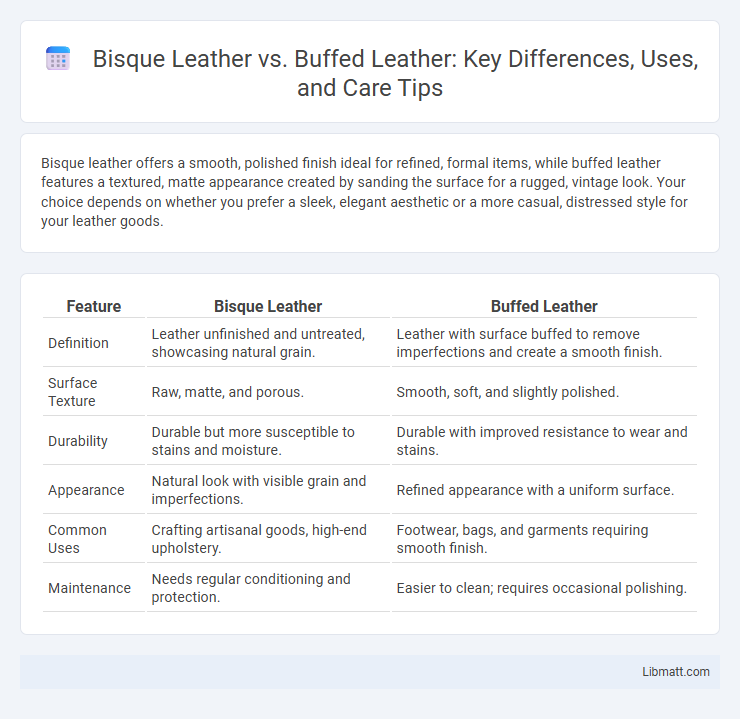Bisque leather offers a smooth, polished finish ideal for refined, formal items, while buffed leather features a textured, matte appearance created by sanding the surface for a rugged, vintage look. Your choice depends on whether you prefer a sleek, elegant aesthetic or a more casual, distressed style for your leather goods.
Table of Comparison
| Feature | Bisque Leather | Buffed Leather |
|---|---|---|
| Definition | Leather unfinished and untreated, showcasing natural grain. | Leather with surface buffed to remove imperfections and create a smooth finish. |
| Surface Texture | Raw, matte, and porous. | Smooth, soft, and slightly polished. |
| Durability | Durable but more susceptible to stains and moisture. | Durable with improved resistance to wear and stains. |
| Appearance | Natural look with visible grain and imperfections. | Refined appearance with a uniform surface. |
| Common Uses | Crafting artisanal goods, high-end upholstery. | Footwear, bags, and garments requiring smooth finish. |
| Maintenance | Needs regular conditioning and protection. | Easier to clean; requires occasional polishing. |
Introduction to Bisque Leather and Buffed Leather
Bisque leather is a type of untreated, natural leather known for its soft texture and light, creamy color, making it ideal for products seeking a raw, rustic aesthetic. Buffed leather undergoes a mechanical buffing process to smooth and slightly alter the surface, enhancing durability and giving it a polished yet matte finish. Understanding the unique qualities of bisque leather and buffed leather helps you choose the right material for your desired look and wear resistance.
Defining Bisque Leather: Key Characteristics
Bisque leather is a type of leather known for its unfinished, raw surface that retains a natural, porous texture, making it highly absorbent and ideal for polishing or dyeing. Unlike buffed leather, which undergoes mechanical abrasion to create a smooth, even surface, bisque leather maintains its rugged and authentic appearance with minimal processing. Its key characteristics include a matte finish, visible grain, and enhanced breathability, which contribute to its popularity in artisanal leather goods and restoration projects.
What is Buffed Leather? An Overview
Buffed leather is a type of treated leather where the surface is lightly abraded to create a soft, velvety texture by removing the top grain. This process enhances the leather's natural appearance while improving flexibility and comfort, making it popular for furniture, apparel, and accessories. You'll find buffed leather offers a unique combination of durability and a smooth, matte finish distinct from the glossy surface of bisque leather.
Differences in Manufacturing Processes
Bisque leather undergoes a unique tanning process involving a soft, creamy finish achieved through minimal surface treatment, preserving its natural texture and flexibility. Buffed leather, on the other hand, is mechanically abraded to smooth out imperfections, resulting in a more uniform appearance with increased softness but less natural grain visibility. Understanding these core manufacturing differences can help you decide which leather type best suits your product's aesthetic and functional requirements.
Texture and Appearance Comparison
Bisque leather features a smooth, matte finish with a soft, supple texture that enhances its natural grain and gives it a refined, understated appearance. Buffed leather, on the other hand, has a slightly rougher surface due to the buffing process, creating a more rugged, distressed look with visible grain patterns. Your choice depends on whether you prefer the elegant, polished feel of bisque leather or the textured, vintage aesthetic of buffed leather.
Durability: Bisque Leather vs Buffed Leather
Bisque leather exhibits superior durability due to its dense fiber structure and natural finish, making it highly resistant to wear and tear. Buffed leather, while softer and more pliable thanks to its sanded surface, tends to show scratches and scuffs more readily, reducing its long-term resilience. When comparing longevity, bisque leather is preferable for applications demanding robust material performance.
Common Applications and Uses
Bisque leather is commonly used for luxury goods such as high-end handbags and furniture upholstery due to its smooth texture and refined finish. Buffed leather, characterized by its slightly rough, matte surface, is favored for casual footwear, work gloves, and rugged outdoor gear because of its durability and grip. Your choice depends on whether you prioritize aesthetic elegance or practical functionality in the intended application.
Maintenance and Care Requirements
Bisque leather demands regular conditioning to prevent drying and cracking, utilizing specialized leather conditioners that maintain its soft, supple texture. Buffed leather requires frequent cleaning to remove surface dirt and may benefit from protective treatments to preserve its matte finish and prevent staining. Your maintenance routine should adapt to these differences, ensuring each type's longevity by addressing their unique care needs.
Price and Availability
Bisque leather generally commands a higher price due to its meticulous tanning process and limited availability, making it a premium choice in the market. Buffed leather tends to be more affordable and widely accessible, as it undergoes a simpler finishing technique that enhances its durability and texture. Depending on your budget and sourcing preferences, buffed leather offers greater availability without compromising on quality.
How to Choose: Bisque or Buffed Leather?
Choosing between bisque leather and buffed leather depends on your desired finish and durability preferences. Bisque leather offers a smooth, matte appearance with excellent moisture resistance, making it ideal for items requiring a refined, low-gloss surface. Buffed leather features a soft, velvety texture and enhanced breathability but may show wear more easily, suitable for casual or vintage-style products.
Bisque leather vs buffed leather Infographic

 libmatt.com
libmatt.com